Intro
After having consolidated its authority within the territory, the weak Capetian dynasty had to face its most powerful vassal:the King of England. It is a first Hundred Years War which is announced. But at the end of this first standoff between France and England, the genius and passion of Philippe Auguste will make the Capetian dynasty a strong and essential power in Europe.
Louis VII the Younger
The reign of Louis VII the Younger
This son of Louis VI who, in 1137, came to power at the age of 16, was an extremely religious man whom his wife, Eleanor of Aquitaine, nicknamed him “the monk”. He demonstrated his faith by actively participating in the second crusade and by asserting himself throughout his life as the protector of the Church. But he did not forget the interests of the Capetian dynasty. By systematically siding with the Church against abusive lords, he succeeded in strengthening his authority throughout the kingdom and even in expanding the domain towards Burgundy and Auvergne. Like his predecessors, Louis VII contributed to the weakening of feudal power. France grew rich under his reign, agriculture was transformed and gained in productivity, the population increased, trade and industry developed, a real intellectual renaissance appeared, and the territory was covered in fortified castles built of stone. Finally, despite his lack of taste for war and despite the power of his adversary, he managed to stand up to the King of England, Henry II.
Louis VII the Younger
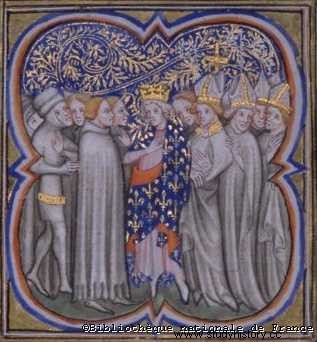
(National Library of France)
Suger, Abbot of Saint-Denis
In the entourage of Louis VI as of Louis VII was a monk who played a leading role and ensured a sort of link between the two reigns. Coming from a poor family, he was entrusted at a very young age to the monks of Saint-Denis Abbey, north of Paris, where he was raised in the company of the future King Louis VI. When he ascended the throne, Suger became a familiar of the royal palace. The king entrusted his friend with very important missions to the pope in Rome and had him elected, in 1122, abbot of Saint-Denis, which was then one of the greatest abbeys in the kingdom. Suger directed the education of the Dauphin Louis. When the latter, having become King Louis VII, left for the crusade, between 1147 and 1149, he was appointed regent of the kingdom. Until his death, he worked to strengthen royal power and improve justice. He advised the two sovereigns he served to rely on the inhabitants, or bourgeois of the towns, against the plundering and undisciplined feudal lords. Cities that requested it were thus granted charters, in which were recorded the rights granted by the king:the ability to dispense justice, to arm themselves, to levy taxes... This was the beginning of the communes. Towards the end of his life, he wrote the lives of the two kings and above all devoted himself to the reconstruction of the church of Saint-Denis.
The birth of Gothic art
In 1144, Abbot Suger inaugurated the new choir of the abbey church of Saint-Denis. He wanted to make his abbey worthy of the relics it housed, and also worthy of preserving the tombs of the kings of France who, since Dagobert, were buried there. So he called on an architect who was a supporter of completely new techniques. The novelty of Gothic churches lies in the discovery of the ogival crossing (two arches crossing at the keystone). This more resistant process made it possible to raise the structure in height and to lighten the roof, in order to free up considerable surfaces for the windows. Later, when the reconstruction of Saint-Denis was completed, Suger, legitimately proud of his work, had engraved at the bottom of a stained glass window:"I myself, Suger, have directed the work".
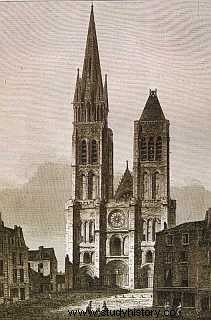
The second crusade (1147 - 1149)
In 1144, the Muslims took over the county of Edessa (one of the four states of the East founded by the Crusaders). The pope then ordered the formation of a new crusade. It was preached by Bernard of Clairvaux, to the assembly of Vézelay (Burgundy), in 1146. The expedition was led by the King of France Louis VII and the Germanic Emperor Conrad III. Disagreements between the leaders, lack of organization and military errors led to a series of setbacks by the Crusader forces. After his troops had been decimated at Dorylaea, Conrad returned to Germany. Louis VII, meanwhile, was inexperienced in waging war, and he often came up against the perfidy of the Byzantines. The survivors joined Jerusalem, then launched an attack against Damascus, without being able to seize this city. News of the arrival of Muslim reinforcements compelled the Christians to break camp and return ingloriously to Europe. In just two years, the prestige of the Crusader armies had fallen so low that one might think that no one would want to take up arms again.
Louis VII leaving for the Second Crusade
Louis VII takes his nickname "Young", because he was the youngest son of Louis VI le Gros. Raised by Suger at the abbey of Saint-Denis, he kept the monastic imprint and the little taste for weapons.
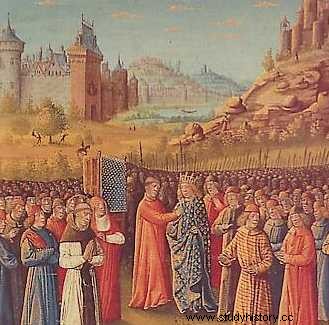
Eleanor of Aquitaine
One of the last measures decided by Louis VI the Fat, fifteen days before his death, in 1137, was to marry his son to the heiress of the rich duchy of Aquitaine, the beautiful Eleanor. By becoming the wife of Louis VII, she allowed the King of France to enter a region where royal authority had until then remained purely theoretical. No sooner had his father's remains been taken to Saint-Denis than Louis VII went to Poitiers to be crowned Duke of Aquitaine. This marriage was a real masterstroke of Suger's diplomacy. The dowry of the young bride made it possible to triple the royal domain, there was then a part of the South and the West of France, that is to say 19 of the current departments. The new queen brought as an inheritance not only the duchy of her father, but also a little of that civilization of Guyenne, more refined and more brilliant than that of northern France. Thus, Aliénor loved the music, the festivals and the songs of the troubadours, these singer-poets who went from castle to castle celebrating the beauty of ladies. Conversely, Louis VII was shy, reserved and very pious, which did not go well with the strong and sensual character of Aliénor. This difference in character, culture, added to the fact that Eleanor was unable to give the king the heir he was hoping for. However, the first ten years seem to pass without any real disagreement.
Eleanor of Aquitaine
"The grandmother of Europe" as she is also called is also a distinguished and cultured woman. It is at the origin of the first maritime code of humanity. This code is known as the "Role and Laws of Oléron" and governs the rules of navigation. She had eight children with Henri II Plantagenêt, then she retired to Poitiers because of her husband's infidelities. While exceptional, Aliénor's life testifies to the very free behavior of women in the Middle Ages, at least in the upper classes. She maintained and spread the Occitan culture of troubadours and courtly love. Aliénor is also the grandmother of Blanche de Castille, the mother of Saint-Louis.
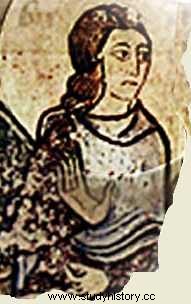
Eleanor, Queen of England
The conflict with France and England had begun after the invasion of the country by the Duke of Normandy, William the Conqueror. The rich Duke, who was the vassal of the King of France was then King of England and one of the most powerful men in Europe. Under his influence, the country prospered and modernized. In 1128, the Count of Anjou, Geoffroy Plantagenêt (due to his habit of wearing a branch of broom on his helmet) married Mathilde of England, the descendant of the Norman kings who owned the Duchy of Normandy. Thus, their son Henri possessed the double inheritance of his parents. During this time, the king of France Louis VII is called to participate in the second crusade, his wife Eleanor of Aquitaine then accompanies him. The next two years deteriorated the couple's relationship. Aliénor tried in vain to convince her husband to help his uncle Raymond de Poitiers, who sat in Antioch. Very close to her uncle, the young queen was suspected of incest by many chroniclers of the time, including William of Tyr. On his return, Louis presented a relationship of consanguinity to the 5th degree with Eleanor, which allowed him to annul the marriage in 1152. Two months later, Eleanor married Henry II Plantagenet who became king of England in 1154. Henry then possessed the throne of England but also half of France with the possessions in Anjou and Normandy of his parents, but also those of Aquitaine brought by Eleanor. This serious political fault is the beginning of a continual rivalry between France and England. Yet the balance of power between the powerful king of England and the Capetian king seems disproportionate. But Louis VII can rely on the Church, and on the despotism of Henri II which pushes his vassals and his sons to revolt against him.
Possessions of the Kings of England and France

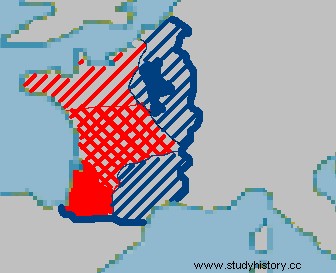
Philip II Augustus
The accession of Philip II Augustus
After Aliénor's repudiation, Louis VII successively married Constance of Castile and Adele of Champagne. The latter gives him a single male heir:Philippe. In 1179, he had him crowned king at Reims, and exhausted by illness, he relinquished power. Louis died in 1180 just after signing the Treaty of Gisors with Henry II of England. Philip II was then only 15 years old. He was then married to Isabelle de Hainaut, a descendant of Charlemagne. The Carolingian dynasty, if it ceased to reign, is still present in the hearts of the French who call it "the race of great kings". The first five years of his reign, Philippe succeeded in triumphing over his cumbersome protectors, the counts of Flanders and Champagne, and in enlarging the royal domain. But the great affair of the reign was of course the struggle with the Plantagenets. Louis VII, aware of his military weaknesses and the power of his adversary, had preferred trickery to open combat. He had supported Brittany and Poitou against the English king, and above all, he had helped Henry's sons who were claiming a share of the inheritance while their father was still alive. Thus Louis VII succeeded little by little in wearing down his rival's strength. His son, Philippe, will choose a different path, seeking confrontation on the battlefield. But when the great Richard the Lionheart succeeded his father in 1189, Philip found himself facing a formidable adversary. However, he agreed to take with him the head of a crusade in Palestine.
The coronation of Philip II
Philippe Auguste is the first king to officially give himself the title of King of France.
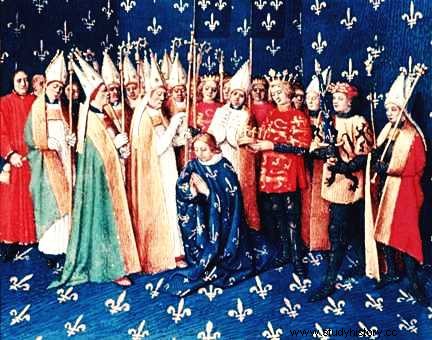
The Third Crusade (1189 - 1192)
Forty years passed, during which Christians and Muslims often lived as good neighbours. Many of the former Crusaders had married Arab women and had adopted many Eastern customs. Commercial exchanges were very intense between the ports of the Levant and those of the Italian coasts. The most important figure in the Muslim world was then the Sultan of Egypt, Salah al-Din, known as Saladin, who had extended his domination over a large part of the Levant and established good relations with the Christians. But the violation of this status quo by a few fanatical lords brought war to the region. Saladin defeated the Christians at the Battle of Attin and entered Jerusalem as the winner in 1187. The capture of the city led to the call for the Third Crusade. It was called the "crusade of kings" because at its head were the most prestigious sovereigns of the West:Emperor Frederic Barbarossa, King Philippe Auguste of France and King Richard the Lionheart of England. The assembled armies were very large. But barely arrived in Asia Minor, Frederick Barbarossa drowned for having crossed a river with his armor. The two surviving sovereigns took over the city of Saint-Jean d'Acre. Then events took another turn. The King of France had only one hurry:to return to his homeland and take advantage of Richard's absence to get his hands on the latter's French possessions. Left alone, the English king performed wonders, but he was no longer able to beat Saladin. So he concludes, in 1192, a truce with his brave adversary. The agreement stipulated that Jerusalem remained in the hands of the Muslims, who in return pledged to protect Christian pilgrims going to the Holy City. In addition, the Franks retained the ports of the Levant, as well as Cyprus.
Siege of Saint-Jean d'Acre
This crusade is certainly one of the most famous. The great Sultan Saladin was highly respected by Christians who considered him the “immaculate reflection of chivalry”. In front of him, Richard Coeur de Lion, a formidable warrior, very enduring in combat. The English king was immortalized by the adventures of Robin Hood.
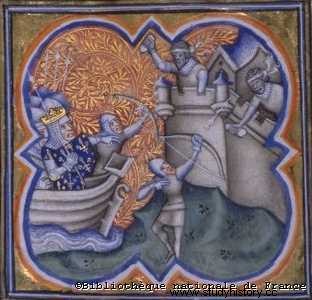
(National Library of France)
The fight against the Lion
The official reason for Philippe Auguste's departure from the Third Crusade was his health. After the capture of Saint-Jean d'Acre, the king fell ill with a spell of typhoid (there was then a rumor of poisoning by the English). But this early departure was not to displease Philippe's ambitions. Once back, the Capetian king takes advantage of the absence of his rival to occupy the Norman Vexin. Richard the Lionheart then decides to return to defend his land. But he was captured and taken prisoner from 1192 to 1193 by the Germanic Emperor Henry VI, son of Frederick Barbarossa. However, once free, Richard inflicts a series of defeats on the King of France. Philippe even fails to fall into an ambush near the forest of Fréteval where he lost his treasure and the archives of the crown. But he demonstrated his great value, particularly at Gisors, where at the head of a cavalry regiment, Philippe found himself facing the entire English army, the king charged at the head of his troops and almost killed himself, he would have declared "No, I would not run away from my vassal." The conflict got bogged down and balanced, the war against Richard was marked by real atrocities, the pope intervened on many occasions as a mediator. It was only after the disappearance of Richard, mortally wounded in front of the castle of Chalus in 1199, that Philip was able to realize his ambition of reconquest.
Philippe Auguste, the unifier
When Richard died, Philippe took advantage of the mistakes made by his younger brother:Jean Sans Terre (so called because he had received no domain). The King of France even managed to have him condemned by a court of great lords of the kingdom:the latter decided that all the strongholds of the Plantagenets in France were to be confiscated. The capture of the English fortress of Château-Gaillard, a real strategic point, allows the attachment of Normandy and Brittany. Philippe was thus able to occupy in 1204, Normandy, Anjou, Maine, Touraine and Poitou. Jean Sans Terre never stopped recovering his property. He even manages to form a very dangerous coalition, uniting against the King of France, the Emperor of Germany and the Count of Flanders. But Philippe got ahead of his enemies and successively defeated the English army at La Roche-aux-Moines and that of his allies at Bouvines. This success allowed him to definitively deprive the Plantagenets of their continental possessions, with the exception, however, of Aquitaine. Throughout Europe, Bouvines crowned the French monarchy with a new prestige. So busy, Philippe cannot participate in the fourth and fifth crusades which are disasters. On his way, Philippe further enlarged the royal domain by adding Auvergne, Artois, the county of Evreux, while his son Louis crossed the Channel, occupied London and all of Eastern England without firing a shot. . The death of Jean Sans Terre, which occurred in the meantime, saved the English monarchy, the English barons rallying to their new king, the young Henry III. Despite this failure, Philippe fully deserved his nickname of Augustus, from the Latin augeo , "he who increases".
The capture of Château-Gaillard
The fortress was built by Richard Coeur de Lion in just one year:"How beautiful my one-year-old daughter is". The English king was inspired for this by the Syrian castles he saw during the third crusade (Kraks of the Holy Land). After seven months of siege, the French cause the collapse of a tower thanks to an ingenious work of undermining (underground gallery). The Anglo-Normans then gathered in the 1st enclosure of the castle. But the French soldiers manage to penetrate there while passing... by the window of the latrines. It is with the support of a catapult that the French will manage to seize the 2nd enclosure. The besieged will be taken before they have time to take refuge in the dungeon.
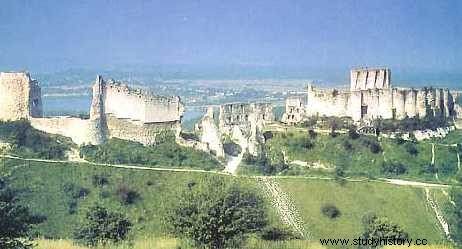
The Battle of Bouvines July 27, 1214
After the defeat of Jean Sans Terre at La Roche-aux-Moines, Philippe Auguste decided to confront the German Emperor Otho and the Count of Flanders. The meeting of the two armies took place in July 1215 on the plateau of Bouvines, between Valenciennes and Lille. During a confused melee, the king of France is unhorsed and nearly captured by the Flemings. He owes his salvation only to the intervention of a few knights. The emperor, in his turn, was attacked and fled, abandoning his standard. But the French fury got the better of the Teutonic infantry. When night fell, the Imperial army was in full retreat. Philip then sounded the trumpets to recall his troops, "who returned to camp with great joy". Despite its confusion, the Battle of Bouvines was an indisputable victory, the repercussions of which were enormous in the kingdom and throughout the West. The return of the army was triumphant. In the villages, the bells were ringing. Tapestries were hung on the facades. In Paris, the bourgeois, the students and the clergy went to meet the king singing hymns. For seven days and seven nights, people danced in the streets of the city. For the first time, the people felt as their own a victory won by the king and his army.
The Battle of Bouvines
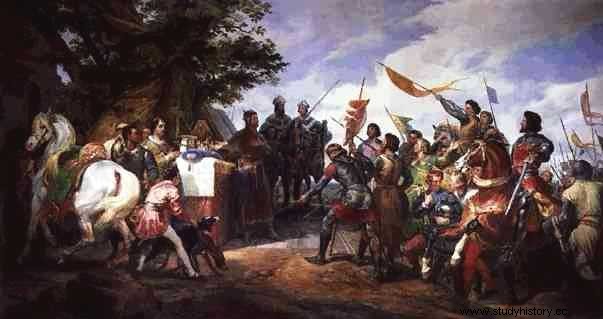
The Battle of Bouvines, by Horace VERNET (Château de Versailles)
The richest kingdom in the West
Philippe Auguste did not spend his life fighting. He organized the administration of the kingdom by creating a body of officials responsible for enforcing his orders:the bailiffs or seneschals. He thus instituted a strong and centralized administration. He levies taxes with zeal from the lords and the clergy in order to carry out his campaigns (the saladine tithe had been created to finance the third crusade). It organizes Justice around Parliament, and limits the power of the lords, by attributing high-level responsibilities to the bourgeoisie of the cities, an ambitious and efficient class. He saw to the embellishment of his capital, which he surrounded with a new enclosure:begun in 1190, it was completed on the eve of Bouvines. He protected the university, to which he granted official status in 1215, and built a new royal residence in the Louvre. Philippe is a protector of arts and letters, he is one of the most educated men of his time. Continuing the policy of his predecessors, he leaned on the bourgeois of the cities against the feudal lords, thus contributing to the development of trade. At his death in 1223, France had become the most powerful kingdom in the Christian West. Married three times, Philippe is the father of an only son from his first marriage to Isabelle de Hainaut. The latter succeeded him under the name of Louis VIII.
